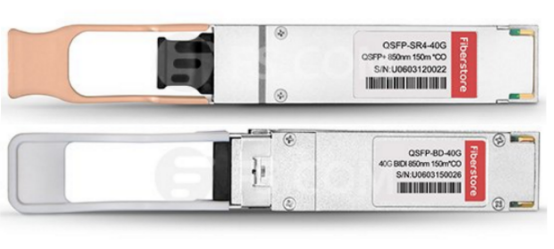November 21, 2016
As the number of cloud applications, big data services and virtualized workloads has increased dramatically over these years, the demand for more capacity and higher transmission speed becomes an urgent task for your network. For the sake of accommodating these applications in your system with higher data transmission rate and better performance, you are suggested to upgrade your network to 40G Ethernet. Hence, you can get a smoothly faster network without buffering that may cause a time delay. Here will introduce two 40G OSFP+ transceiver solutions for data center short distance transmission and analyze their features for you, which may be helpful when you deploy 40G Ethernet network for your system.
As we know, 40GBASE-SR4 QSFP+ transceiver and 40GBASE-SR BiDi QSFP+ transceiver are designed for short distance transmission, but their features are extremely different from each other, varying from working principle to cabling method. The transceivers in following figure are examples of these two kinds of 40G transceivers, Cisco QSFP-40G-SR-BD and Cisco QSFP-40G-SR4 for your reference.

The word SR from 40GBASE-SR4 QSFP+ transceiver stands for short reach. For its name, it is easily to acquire that this kind transceiver is designed for 40G connectivity in a QSFP form factor. When working for a 40G data transmission, it can support the connection at lengths up to 150 meters over OM4 multimode fiber optic cables (MMF).
However, as the aggregation-layer fiber infrastructure is built for 10G connectivity in most data center networks that either supports direct connections between devices over LC-to-LC MMF, or uses LC-to-LC fibers to attach devices to patch panels, we should note that the regular duplex LC-to-LC fibers cannot be directly reused for 40G connectivity by using 40GBASE-SR4 QSFP+ transceiver.
The QSFP BiDi (bi-directional) transceiver was firstly published by Cisco, which has the ability to transmit 40G signals over duplex multimode fiber optic cables with LC connectors, addressing the challenges of fiber infrastructure. In contrast to 40GBASE-SR4 QSFP+ transceiver, it can support 40G connection over only one pair of duplex MMF cables, which allows 40G to be deployed by using the same infrastructure as 10G (10GBASE-SR) without the need to add any additional fibers. When transmitting 40G signals over a duplex OM3 MMF, it can support the transmission at lengths up to 100 meters. What’s more, it can reach 150 meters over OM4 MMF for 40G transmission.
The working principles of these two transceivers are not similar at all. As for the working principle of 40GBASE-SR4 QSFP+ transceiver, we can learn from the following figure. There are two independent sections, transmitter and receiver and 12 parallel fiber strands in a whole working process. The signal will be sent from the transmitter over 4 parallel fiber strands, while transmitted to the receiver over another 4 parallel fiber strands. Thereby 8 fiber strands are required for transmitting signals. Besides, 12-fiber MPO connectors are used in 40GBASE-SR4 QSFP+ transceiver, with 4 fiber strands wasted as shown in the following figure.

Instead of 12 parallel fiber strands with 12-fiber MPO connectors, there are only a pair of duplex MMF cables with duplex LC connectors in QSFP BiDi (bi-directional) transceiver. The duplex MMF cables offer two 20G channels to transmit and receive 20G signals simultaneously with different wavelengths, therefore an aggregated duplex 40G link over two duplex MMF strands shown can be accomplished without adding extra fiber cables. To better understand the working principle, the following figure shows how QSFP BiDi (bi-directional) transceiver transmit two 20G signals over two duplex MMF fiber cables to finish 40G connection.

From what illustrated above, we can see that both the 40GBASE-SR4 QSFP+ transceiver and 40GBASE-SR BiDi QSFP+ transceiver are designed for short distance transmission with different features. Since there are 12 parallel fiber strands with 12-fiber MPO connectors in 40GBASE-SR4 QSFP+ transceiver, with additional products like MTP/MPO cassettes for better cabling, its cabling infrastructure method must be much more complicated than that of QSFP BiDi (bi-directional) transceiver. In contrary, QSFP BiDi (bi-directional) transceiver allows 40G to be deployed with the same infrastructure as 10G (10GBASE-SR) without any additional fibers. Hence, QSFP BiDi (bi-directional) transceiver could be a good choice for you to deploy 40G Ethernet network.
Posted by: katherinewangfs at
10:24 AM
| No Comments
| Add Comment
Post contains 715 words, total size 6 kb.
35 queries taking 0.088 seconds, 65 records returned.
Powered by Minx 1.1.6c-pink.









